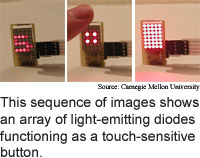
LED array turned into touch
button
A researcher from Carnegie Mellon University
is using a grid of light-emitting diodes, which are widely used as light
sources, as an input device.
The ability of light-emitting diodes to sense light is a well
understood but little-used property. In fact, existing light-emitting
diode displays can be made touch-sensitive without adding appreciably
to the cost of the display, according to the researcher. In some cases
a simple circuit change is needed, and in others only a software change.
The researcher's prototype acts as a touch button. Because it
is also a display, it is also capable of showing prompts.
The advantages to using light-emitting diodes as switches are
the ability to combine prompting with input and being able to do so in
a sealed device that has no moving parts. Many existing appliances already
sport light-emitting diode arrays. In these cases it is relatively easy
and extremely inexpensive to add simple input and interactivity to the
device, according to the researcher.
The researcher's technique requires at least two light-emitting
diodes, one that senses light and one that emits light. When a translucent
or reflective object like a finger makes contact, it reflects light from
the emitting diode onto the sensing diode. The device can be configured
as a button by triggering an action when the intensity of the sensed light
passes a threshold corresponding to an object touching the device.
Input devices based on the touch sensing capabilities of light-emitting
diodes can be used practically now, according to the researcher.
The work was presented at the User Interface Software and Technology
2004 conference (UIST '04) held in Santa Fe, October 24 to 27.
TRN's Top Picks:
Technology Research Advances of 2004
Letter to readers
Briefs:
Alcohol fuel cell goes micro
LED array turned into touch button
Coated nanotubes make biosensors
Gestures control true 3D display
Atom demo fixes quantum errors
Virtual turntable simplifies sharing
Molecular motor goes both ways
Solar cell teams plastic and carbon
DNA makes and breaks particle clumps
Sapphire steps shape nanotubes arrays

Research Watch blog
View from the High Ground Q&A
How It Works
RSS Feeds:
News
Ad links:
Buy an ad link
Ad links: Clear History
Buy an ad link
|
TRN
Newswire and Headline Feeds for Web sites
|
© Copyright Technology Research News, LLC 2000-2010. All rights reserved.